A Fast Cross-Correlation Combined with Interpolation Algorithms for the LiDAR Working in the High Background Noise
Abstract
1. Introduction
2. LiDAR System and Initial Experiments
2.1. The Structure of LiDAR and Specifications
2.2. The Waveforms Obtained at Different Light Intensities
3. Proposed Methods
3.1. The Original Cross-Correlation
3.2. Fast Cross-Correlation (fCC)
- Step 1: Add stop signals to determine the correct stop pulse from background noises.
- Step 2: Implement the cross-correlation function (CCF) on the reduced start signal with the sum of the stop signals .
3.3. Combining the Fast Cross-Correlation (fCC) with Interpolation Algorithms
3.3.1. Combining the fCC with Parabolic (fCCP), Gaussian (fCCG), and Cosine (fCCC) Interpolation
- Parabolic Function (5) and interpolation Formula (6):
- Gaussian Function (7) and interpolation Formula (8):
- Cosine Function (9) and interpolation Formula (10):
3.3.2. Combining the fCC with Cubic Spline Interpolation (fCCS)
4. Experimental Results
4.1. Installed Experiments and Evaluation Methods
4.2. Comparing the Execution Time
4.3. Comparing the Accuracy
4.4. Comparing the Precision
4.5. Compare the Results with Performance of Commercial LiDARs and Recent Research
5. Discussion
6. Conclusions
Author Contributions
Funding
Acknowledgments
Conflicts of Interest
References
- Badue, C.; Guidolini, R.; Carneiro, R.V.; Azevedo, P.; Cardoso, V.B.; Forechi, A.; Jesus, L.; Berriel, R.; Paixão, T.M.; Mutz, F.; et al. Self-driving cars: A survey. Expert Syst. Appl. 2019, 165, 113816. [Google Scholar] [CrossRef]
- Vargas, J.; Alsweiss, S.; Toker, O.; Razdan, R.; Santos, J. An overview of autonomous vehicles sensors and their vulnerability to weather conditions. Sensors 2021, 21, 5397. [Google Scholar] [CrossRef] [PubMed]
- Zang, S.; Ding, M.; Smith, D.; Tyler, P.; Rakotoarivelo, T.; Kaafar, M.A. The Impact of Adverse Weather Conditions on Autonomous Vehicles: How Rain, Snow, Fog, and Hail Affect the Performance of a Self-Driving Car. IEEE Veh. Technol. Mag. 2019, 14, 103–111. [Google Scholar] [CrossRef]
- Hecht, J. Lidar for Self-Driving Cars. Opt. Photonics News 2018, 29, 26–33. [Google Scholar] [CrossRef]
- Chavez-Garcia, R.O.; Aycard, O. Multiple Sensor Fusion and Classification for Moving Object Detection and Tracking. IEEE Trans. Intell. Transp. Syst. 2016, 17, 525–534. [Google Scholar] [CrossRef]
- Zhao, M.; Mammeri, A.; Boukerche, A. Distance measurement system for smart vehicles. In Proceedings of the 2015 7th International Conference on New Technologies, Mobility and Security (NTMS), Paris, France, 27–29 July 2015; pp. 1–5. [Google Scholar] [CrossRef]
- Bengler, K.; Dietmayer, K.; Farber, B.; Maurer, M.; Stiller, C.; Winner, H. Three decades of driver assistance systems: Review and future perspectives. IEEE Intell. Transp. Syst. Mag. 2014, 6, 6–22. [Google Scholar] [CrossRef]
- Khairul, I.; Bhuiyan, A. LiDAR Sensor for Autonomous Vehicle; Technical Report; Technische Universität Chemnitz: Chemnitz, Germany, 2017. [Google Scholar] [CrossRef]
- Behroozpour, B.; Sandborn, P.A.M.; Wu, M.C.; Boser, B.E. Lidar System Architectures and Circuits. IEEE Commun. Mag. 2017, 55, 135–142. [Google Scholar] [CrossRef]
- Rapp, J.; Tachella, J.; Altmann, Y.; McLaughlin, S.; Goyal, V.K. Advances in Single-Photon Lidar for Autonomous Vehicles: Working Principles, Challenges, and Recent Advances. IEEE Signal. Process. Mag. 2020, 37, 62–71. [Google Scholar] [CrossRef]
- Sun, W.; Hu, Y.; MacDonnell, D.G.; Weimer, C.; Baize, R.R. Technique to separate lidar signal and sunlight. Opt. Express 2016, 24, 12949. [Google Scholar] [CrossRef]
- Hao, Q.; Cao, J.; Hu, Y.; Yang, Y.; Li, K.; Li, T. Differential optical-path approach to improve signal-to-noise ratio of pulsed-laser range finding. Opt. Express 2014, 22, 563. [Google Scholar] [CrossRef]
- Cheng, Y.; Cao, J.; Hao, Q.; Xiao, Y.; Zhang, F.; Xia, W.; Zhang, K.; Yu, H. A novel de-noising method for improving the performance of full-waveform LiDAR using differential optical path. Remote Sens. 2017, 9, 1109. [Google Scholar] [CrossRef]
- Beer, M.; Haase, J.F.; Ruskowski, J.; Kokozinski, R. Background light rejection in SPAD-based LiDAR sensors by adaptive photon coincidence detection. Sensors 2018, 18, 4338. [Google Scholar] [CrossRef] [PubMed]
- Li, H.; Chang, J.; Xu, F.; Liu, Z.; Yang, Z.; Zhang, L.; Zhang, S.; Mao, R.; Dou, X.; Liu, B. Efficient lidar signal denoising algorithm using variational mode decomposition combined with a whale optimization algorithm. Remote Sens. 2019, 11, 126. [Google Scholar] [CrossRef]
- Mei, L.; Zhang, L.; Kong, Z.; Li, H. Noise modeling, evaluation and reduction for the atmospheric lidar technique employing an image sensor. Opt. Commun. 2018, 426, 463–470. [Google Scholar] [CrossRef]
- Zhou, M.; Li, C.R.; Ma, L.; Guan, H.C. Land cover classification from full-waveform Lidar data based on support vector machines. Int. Arch. Photogramm. Remote Sens. Spat. Inf. Sci. ISPRS Arch. 2016, 41, 447–452. [Google Scholar] [CrossRef]
- Agishev, R.; Gross, B.; Moshary, F.; Gilerson, A.; Ahmed, S. Simple approach to predict APD/PMT lidar detector performance under sky background using dimensionless parametrization. Opt. Lasers Eng. 2006, 44, 779–796. [Google Scholar] [CrossRef]
- Fersch, T.; Weigel, R.; Koelpin, A. Challenges in miniaturized automotive long-range lidar system design. In Three-Dimensional Imaging, Visualization, and Display 2017; International Society for Optics and Photonics: Bellingham, WA, USA, 2017; Volume 10219, p. 102190T. [Google Scholar] [CrossRef]
- Nguyen, T.; Cheng, C.; Liu, D.; Le, M. Improvement of Accuracy and Precision of the LiDAR System Working in High Background Light Conditions. Electronics 2022, 11, 45. [Google Scholar] [CrossRef]
- Lai, X.; Torp, H. Interpolation methods for time-delay estimation using cross-correlation method for blood velocity measurement. IEEE Trans. Ultrason. Ferroelectr. Freq. Control 1999, 46, 277–290. [Google Scholar] [CrossRef]
- Luciano, N.B.; Alberto, S.C.J.; Carlos, P.O.J.; Manuel, R.A.J. Development of an ultrasonic thickness measurement equipment prototype. In Proceedings of the 2010 20th International Conference on Electronics Communications and Computers (CONIELECOMP), Cholula, Mexico, 22–24 February 2010; pp. 124–129. [Google Scholar] [CrossRef]
- Tsai, W.Y.; Huang, C.F.; Liao, T.L. New implementation of high-precision and instant-response air thermometer by ultrasonic sensors. Sens. Actuators A Phys. 2005, 117, 88–94. [Google Scholar] [CrossRef]
- Padmanabhan, P.; Zhang, C.; Charbon, E. Modeling and analysis of a direct time-of-flight sensor architecture for LiDAR applications. Sensors 2019, 19, 5464. [Google Scholar] [CrossRef]
- Tontini, A.; Gasparini, L.; Perenzoni, M. Numerical model of spad-based direct time-of-flight flash lidar CMOS image sensors. Sensors 2020, 20, 5203. [Google Scholar] [CrossRef] [PubMed]
- Zhang, C.; Lindner, S.; Antolovic, I.M.; Mata Pavia, J.; Wolf, M.; Charbon, E. A 30-frames/s, 252 × 144 SPAD Flash LiDAR with 1728 Dual-Clock 48.8-ps TDCs, and Pixel-Wise Integrated Histogramming. IEEE J. Solid-State Circuits 2019, 54, 1137–1151. [Google Scholar] [CrossRef]
- Kao, Y.H.; Chu, T.S. A Direct-Sampling Pulsed Time-of-Flight Radar With Frequency-Defined Vernier Digital-to-Time Converter in 65 nm CMOS. IEEE J. Solid-State Circuits 2015, 50, 2665–2677. [Google Scholar] [CrossRef]
- Hoseini, M.R.; Wang, X.; Zuo, M.J. Estimating ultrasonic time of flight using envelope and quasi maximum likelihood method for damage detection and assessment. Meas. J. Int. Meas. Confed. 2012, 45, 2072–2080. [Google Scholar] [CrossRef]
- Shaswary, E.; Tavakkoli, J.; Xu, Y. A new algorithm for time-delay estimation in ultrasonic echo signals [Correspondence]. IEEE Trans. Ultrason. Ferroelectr. Freq. Control 2015, 62, 236–241. [Google Scholar] [CrossRef]
- Li, X.; Yang, B.; Xie, X.; Li, D.; Xu, L. Influence of waveform characteristics on LiDAR ranging accuracy and precision. Sensors 2018, 18, 1156. [Google Scholar] [CrossRef]
- Wagner, W.; Ullrich, A.; Melzer, T.; Briese, C.; Kraus, K. From Single-Pulse to Full-Waveform Scanners: Potential and Practical Challenges. Int. Arch. Photogramm. Remote Sens. Spat. Inf. Sci. 2004, 35, 201–206. [Google Scholar]
- Shan, J.; Toth, C.K. Topograpic Laser Ranging and Scanning: Principles and Processing, 2nd ed.; CRC: Boca Raton, FL, USA, 2018; ISBN 9781498772273. [Google Scholar]
- Nguyen, T.T.; Cheng, C.H.; Liu, D.G.; Tran, S.T.; Le, M.H. An Overlapping and Leading Edge Detection Combined Technique for Distance Estimation under High-Background Lights in a Pulsed-LiDAR System. In Proceedings of the 2021 3rd International Electronics Communication Conference (IECC), New York, NY, USA, 8–10 July 2021; pp. 11–16. [Google Scholar] [CrossRef]
- Azaria, M.; Hertz, D. Time Delay Estimation by Generalized Cross Correlation Methods. IEEE Trans. Acoust. 1984, 32, 280–285. [Google Scholar] [CrossRef]
- Li, C.; Chen, Q.; Gu, G.; Qian, W. Laser time-of-flight measurement based on time-delay estimation and fitting correction. Opt. Eng. 2013, 52, 076105. [Google Scholar] [CrossRef][Green Version]
- Reddy, V.R.; Gupta, A.; Reddy, T.G.; Reddy, P.Y.; Reddy, K.R. Correlation techniques for the improvement of signal-to-noise ratio in measurements with stochastic processes. Nucl. Instrum. Methods Phys. Res. Sect. A Accel. Spectrom. Detect. Assoc. Equip. 2003, 501, 559–575. [Google Scholar] [CrossRef]
- Nguyen, T.H.; Chabah, M.; Sintes, C. Correlation bias analysis—A novel method of sinus cardinal model for least squares estimation in cross-correlation. In Proceedings of the OCEANS 2015—MTS/IEEE Washington, Washington, DC, USA, 19–22 October 2015. [Google Scholar] [CrossRef]
- Céspedes, I.; Huang, Y.; Ophir, J.; Spratt, S. Methods for Estimation of Subsample Time Delays of Digitized Echo Signals. Ultrason. Imaging 1995, 17, 142–171. [Google Scholar] [CrossRef] [PubMed]
- Viola, F.; Walker, W.F. A spline-based algorithm for continuous time-delay estimation using sampled data. IEEE Trans. Ultrason. Ferroelectr. Freq. Control 2005, 52, 80–93. [Google Scholar] [CrossRef] [PubMed]
- Svilainis, L.; Lukoseviciute, K.; Dumbrava, V.; Chaziachmetovas, A. Subsample interpolation bias error in time of flight estimation by direct correlation in digital domain. Meas. J. Int. Meas. Confed. 2013, 46, 3950–3958. [Google Scholar] [CrossRef]
- Svilainis, L. Review on Time Delay Estimate Subsample Interpolation in Frequency Domain. IEEE Trans. Ultrason. Ferroelectr. Freq. Control 2019, 66, 1691–1698. [Google Scholar] [CrossRef] [PubMed]
- Leica DISTO Lite 5 Laser Distance Meter. Available online: https://www.libble.eu/leica-disto-lite-5/online-manual-794280/ (accessed on 25 January 2022).
- Viola, F.; Walker, W.F. Computationally efficient spline-based time delay estimation. IEEE Trans. Ultrason. Ferroelectr. Freq. Control 2008, 55, 2084–2091. [Google Scholar] [CrossRef]
- Pinton, G.F.; Trahey, G.E. Continuous delay estimation with polynomial splines. Proc. IEEE Ultrason. Symp. 2006, 1, 1702–1705. [Google Scholar] [CrossRef]
- Ryan, M. Computational Nuclear Engineering and Radiological Science Using Python; Elsevier: Amsterdam, The Netherlands, 2018; ISBN 9780128122532. [Google Scholar]
- Kong, Q.; Siauw, T.; Bayen, A.M. Python Programming and Numerical Methods; Academic Press: Cambridge, MA, USA, 2021; ISBN 9780128195499. [Google Scholar]
- Xie, X.; Xu, L.; Wang, Z.; Li, X. Real-Time in Situ Laser Ranging Based on Online Echo Waveform Fitting. IEEE Sens. J. 2019, 19, 9255–9262. [Google Scholar] [CrossRef]
- RPLiDAR A3. Available online: https://www.slamtec.com/en/Lidar/A3 (accessed on 2 March 2022).
- Ultra-Puck LiDAR. Available online: https://velodynelidar.com/products/ultra-puck/ (accessed on 2 March 2022).


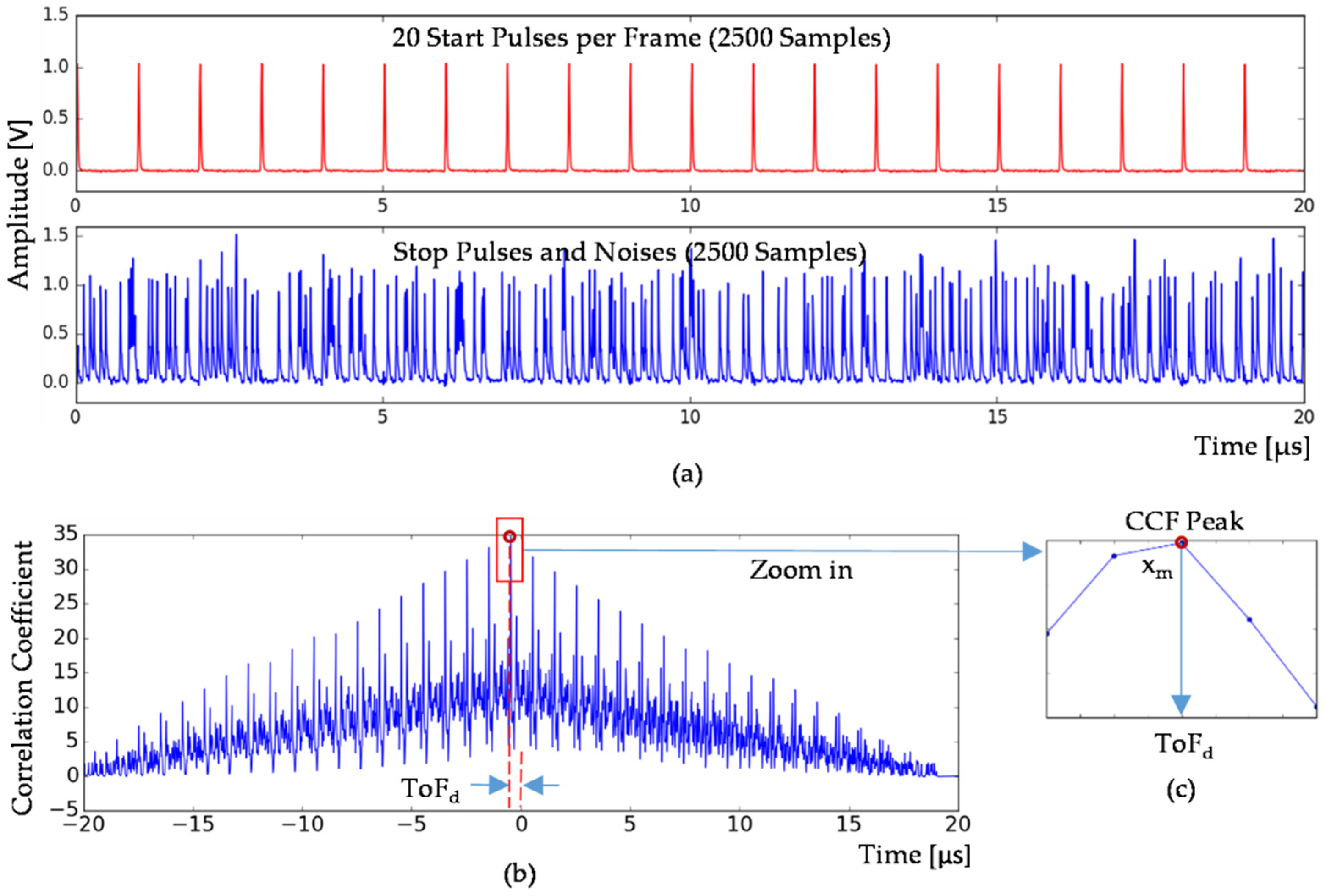
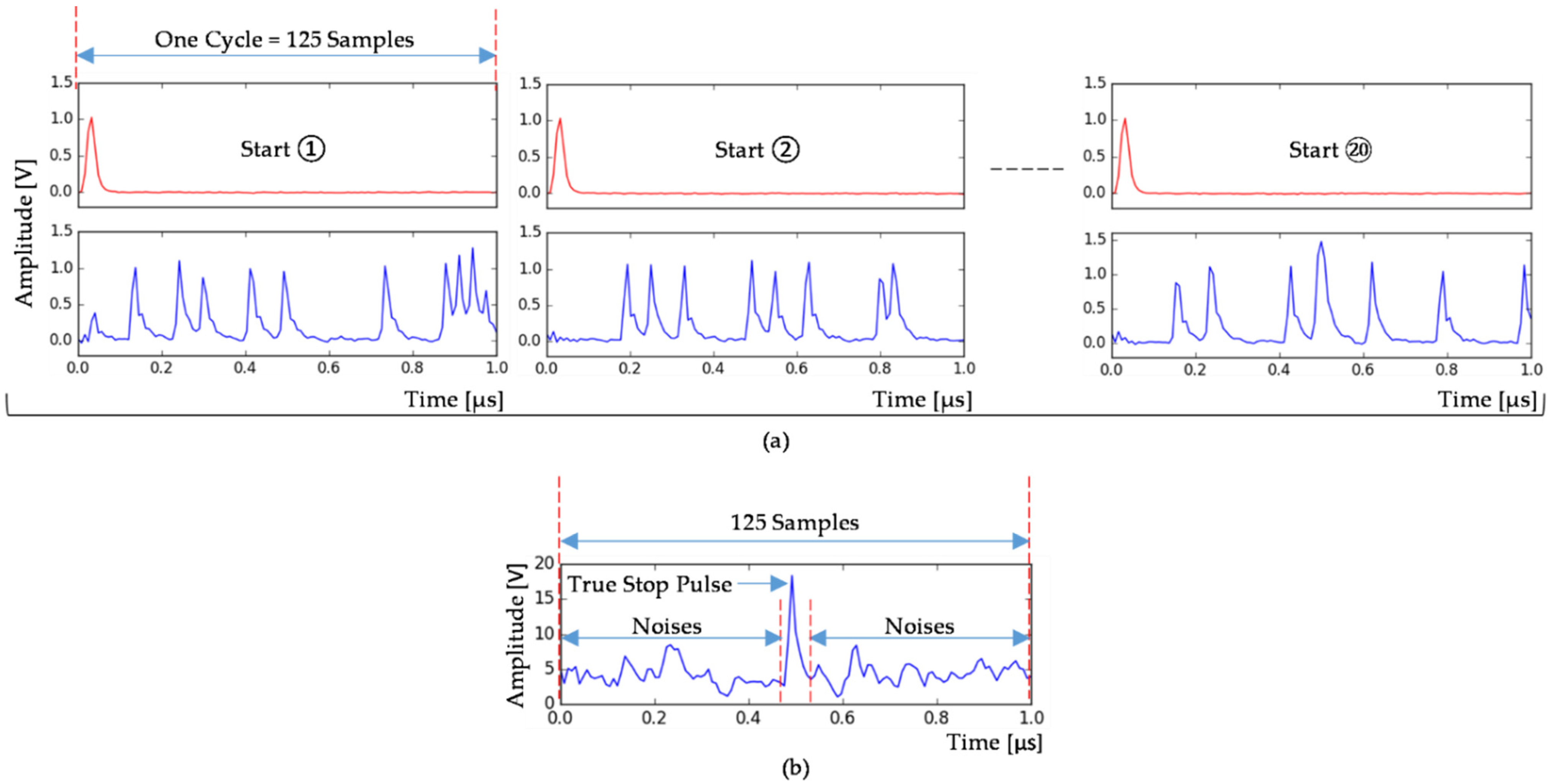


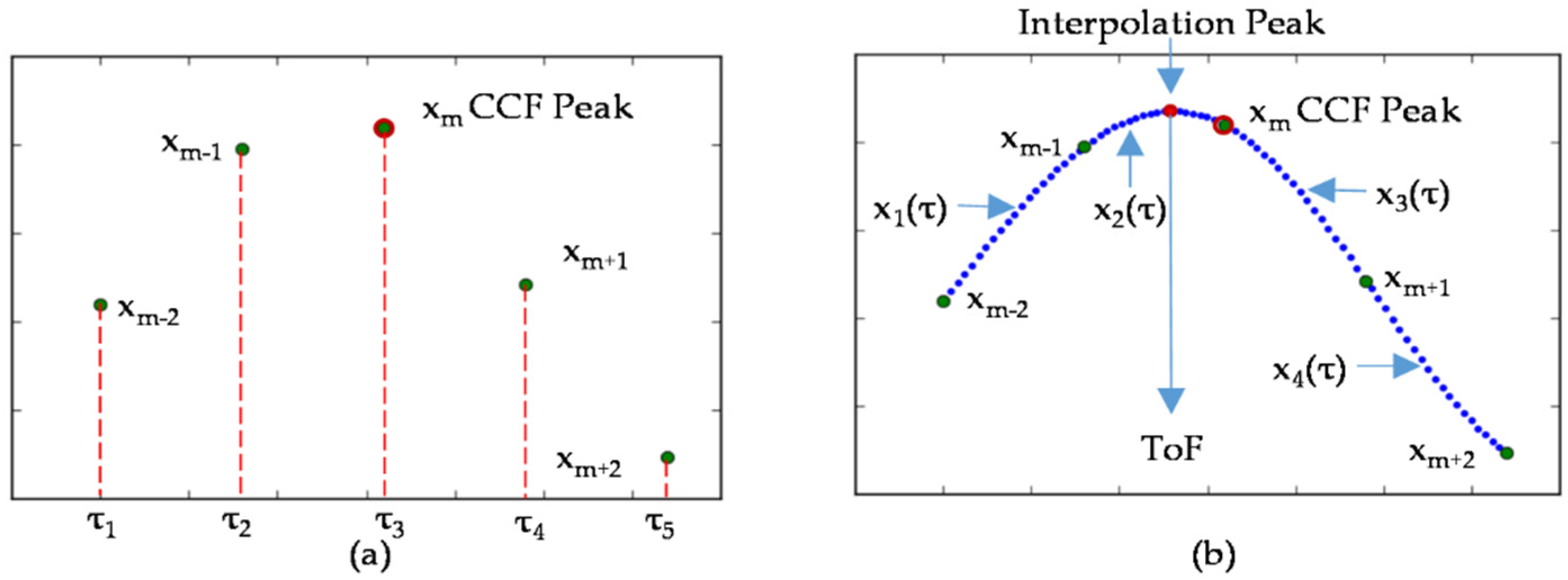
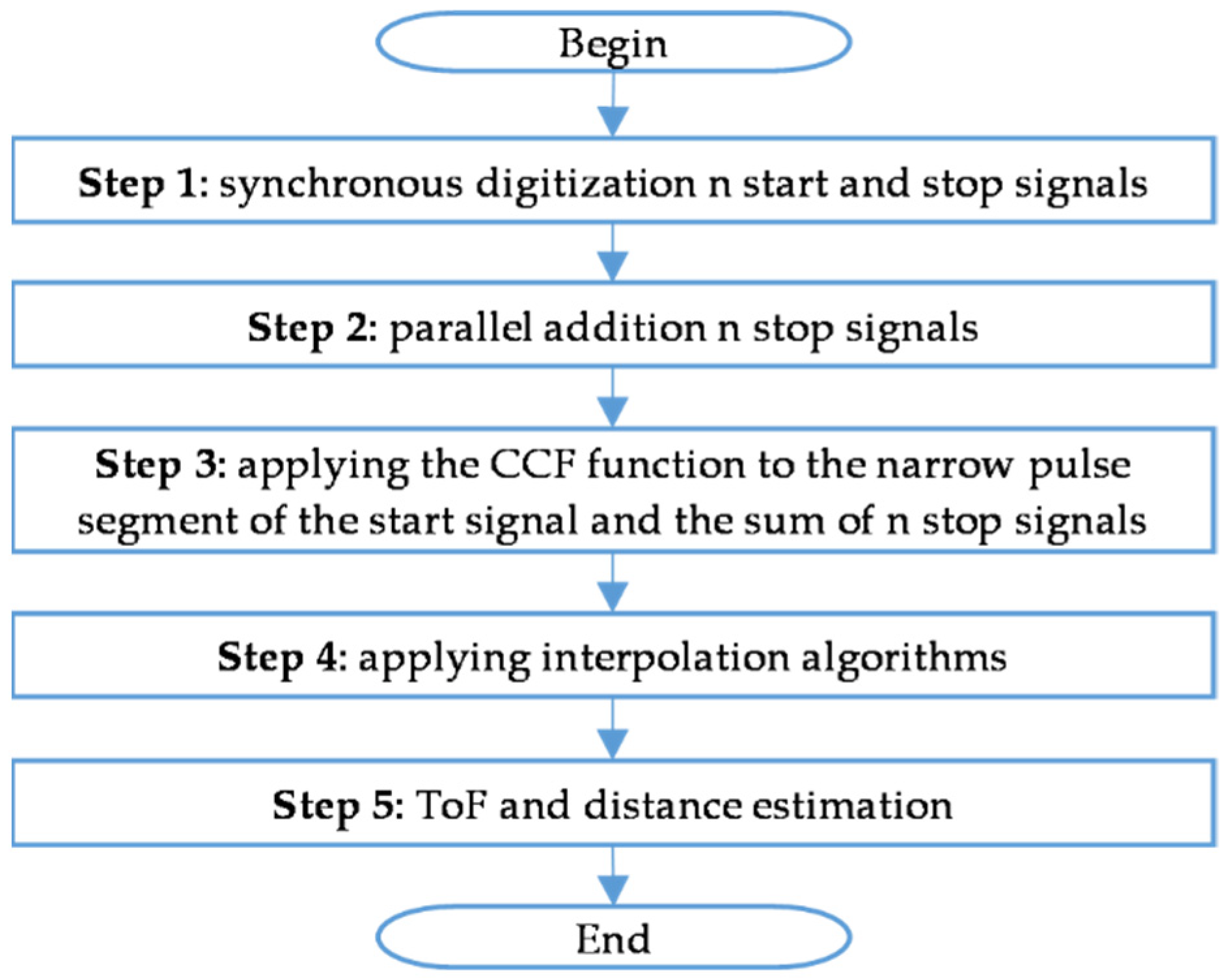



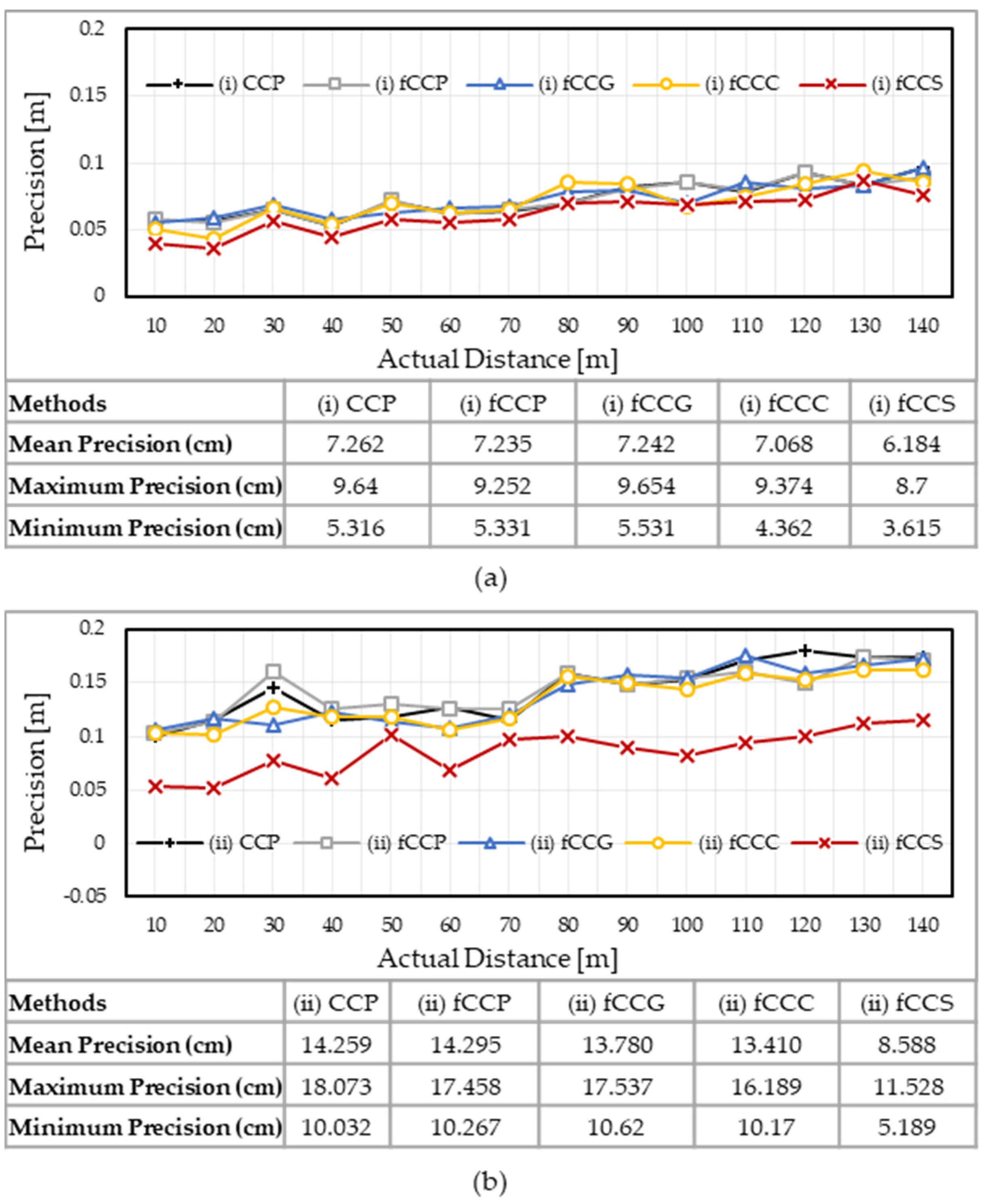
| Parameters | Specifications |
|---|---|
| 1. Emitting block | |
| Emitted frequency | F = 1 MHz |
| Pulse width | 20 ns |
| Diameter of aspheric lens | 6.35 mm |
| Focal of aspheric lens | 3.1 mm |
| Peak power of laser | 250 mW |
| Average power of laser | 2 mW |
| Wavelength of laser | 650 nm |
| Width of laser beam | 2.53 mm |
| 2. Received block | |
| SPAD sensor | Single-pixel |
| Active area of sensor | 314 μm2 |
| Focal lens | 60 mm |
| Diameter of focus lens | 25.4 mm |
| Field of view angle | 0.024° |
| Bandpass filter lens | 650 nm |
| 3. Signal processing block | |
| Embedded platform | Red Pitaya STEM Lab 125-14 |
| Processor unit | ARM cortex A9, 667 MHz |
| Ram memory | 512 MB |
| Sampling rate of ADCs | = 125 Msps |
| Operating system | A lightweight version of Linux |
Publisher’s Note: MDPI stays neutral with regard to jurisdictional claims in published maps and institutional affiliations. |
© 2022 by the authors. Licensee MDPI, Basel, Switzerland. This article is an open access article distributed under the terms and conditions of the Creative Commons Attribution (CC BY) license (https://creativecommons.org/licenses/by/4.0/).
Share and Cite
Nguyen, T.-T.; Cheng, C.-H.; Liu, D.-G.; Le, M.-H. A Fast Cross-Correlation Combined with Interpolation Algorithms for the LiDAR Working in the High Background Noise. Electronics 2022, 11, 985. https://doi.org/10.3390/electronics11070985
Nguyen T-T, Cheng C-H, Liu D-G, Le M-H. A Fast Cross-Correlation Combined with Interpolation Algorithms for the LiDAR Working in the High Background Noise. Electronics. 2022; 11(7):985. https://doi.org/10.3390/electronics11070985
Chicago/Turabian StyleNguyen, Thanh-Tuan, Ching-Hwa Cheng, Don-Gey Liu, and Minh-Hai Le. 2022. "A Fast Cross-Correlation Combined with Interpolation Algorithms for the LiDAR Working in the High Background Noise" Electronics 11, no. 7: 985. https://doi.org/10.3390/electronics11070985
APA StyleNguyen, T.-T., Cheng, C.-H., Liu, D.-G., & Le, M.-H. (2022). A Fast Cross-Correlation Combined with Interpolation Algorithms for the LiDAR Working in the High Background Noise. Electronics, 11(7), 985. https://doi.org/10.3390/electronics11070985







